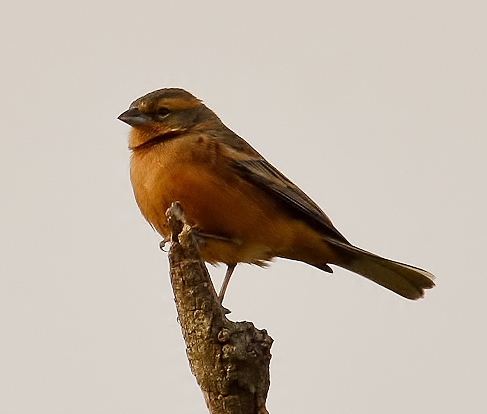 |
| Photo by Federico Villegas (Ecoregistros) |
Common name:
cinnamon warbling-finch (en); capacetinho-canela (pt); chipiu cannelle (fr); monterita canela (es); schmuckammerfink (de)
Taxonomy:
Order Passeriformes
Family Emberizidae
Range:
This species in endemic to Argentina, being found in the eastern part of the country from the provinces of Salta and Catamarca to Neuquén, Río Negro and southern Buenos Aires.
Size:
These birds are 13 cm long and weigh 10-15 g.
Habitat:
The cinnamon warbling-finch is mostly found in dry woodlands and scrublands, also using pastures and arable land. They are present from sea level up to an altitude of 1.000 m.
Diet:
They are mainly granivorous, eating the seeds of various grasses and forbs such as Setaria leucophylla, Sporobolus cryptandrus and Chenopodium papulosum. During the spring they supplement their diet with some arthropods and fruits.
Breeding:
Cinnamon warbling-finches breed in November-January. They nest in an open cup nests made of grass and forb stems, hairy achenes of composites, spider oothecas and silk. It is lined with thin vegetable fibres and placed on the grass among grasses and scrubs. The female lays 3-4 eggs, which she incubates alone for 10 days. The chicks are fed by both parents and fledge 8-9 days after hatching.
Conservation:
IUCN status – LC (Least Concern)
This species has a large breeding range and is described as uncommon to fairly common. The population is suspected to be stable in the absence of evidence for any declines or substantial threats. The cinnamon warbling-finch may be highly sensitive to human activities that affect both vegetation cover and food abundance, also being negatively affected by droughts.







